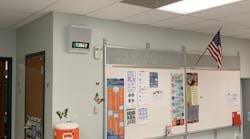While debates over implementing tighter gun control measures and allocating funding for mental health initiatives have become commonplace in the wake of every school shooting, these tragedies have also served as a referendum of sorts on what security technologies schools should be investing their financial resources on. Nearly everyone agrees that improving school security starts at the door with access control limiting who can and cannot be on the campus, followed closely by an actively monitored video surveillance network.
After that, however, the exact measures that schools should be leveraging have been a subject of debate. Some politicians, including President Donald Trump, have advocated for arming teachers and school administrators to be able respond in the event of an active shooter, while others have proposed increasing the presence of law enforcement or armed security personnel on campuses. Still others believe that ramping up the use of technology within schools with devices like metal detectors and panic alarms may be the better option.
Regardless of which camp you fall into or if you believe a combination of these solutions is the most appropriate solution, the fact is that this discussion is not going away anytime soon. One company that offers its own unique solution to schools to help them respond better in the event of any kind of incident, be it man-made or natural, is BluePoint Alert Solutions. The company, which offers both emergency communications hardware as well as command and control software, has had its technology deployed in over 150 schools, including both K-12 and higher education campuses, across the nation.
SecurityInfoWatch.com (SIW) recently sat down with John Shales, the co-founder and CMO of BluePoint, to discuss how the market for security technology has evolved on education campuses in recent years and where he believes it is headed moving forward.
SIW: How has the recent uptick in school security spending in various states across the country and the intense scrutiny on campus safety and mitigating active shooters impacted your business?
Shales: Most of the people we’re talking to nationwide are confused about how to access these dollars, especially on the federal side, because there’s not great clarity on that. We’ve tried to help with that but it has been difficult to get figured out. Many states have a similar problem. In Michigan, for example, they have great clarity on how to access those dollars although there is a very short timeframe – a 60-day window to submit (for aid) – so there has been a lot of requests for our system from schools in the state and we’ve been helping them with that.
These grants that are coming out though really have a good focus to them for the most part… with funding for putting additional officers in schools as well as technology and training. All the grants we’ve seen are really focused in on those three things and we fully support that.
SIW: One of the things that is always talked about relative to school security is the limited budgets that many districts are forced to operate within, so how do you work with schools and integrators to get them to design and implement a comprehensive security solution?
Shales: We’ve worked with a couple of schools this year to come up with some creative solutions to make improvements. One of the approaches was a school that took advantage of essentially a lease to own type of arrangement where they paid out a certain amount over time. They brought the board members in and figured out how they could adjust their budget to minimize the impact on one year and spread it out over a series of years. That’s not a route that schools typically take but it something that some have been willing to explore.
Another school had allocated money for carpet replacement and it was sufficient to put it a security system, so they’re waiting another year to get carpet but gain security earlier. You would think that would be a pretty straightforward proposition but in many school administrations it is not as straightforward as you might think.
SIW: In the wake of Parkland and Santa Fe, more recently, where do you think we need to start to move forward in trying to mitigate these mass casualty events in schools?
Shales: Prevention would be awesome and, obviously, I think the conversations around gun control are not really going to work in the short term. Preventions are good but they are super complicated and they are going to take a long time to get there. Even on the mental health side, I don’t think you would ever get to the point of fully preventing something from happening. We make a lot of connections to a fire alarm and you would like to prevent all fires but you’re never going to, so it is just one of those facts of life.
In Santa Fe during the panic, someone thought to pull the fire alarm and that’s the good side that there has been enough training that has been ingrained into us as people that we have these systems available and they do good. The unfortunate part is that it caused more confusion in this case. I think training is going to be a key part to this on what to do and what does this look like moving forward. How do you run? How do you fight? Those are important discussions to have and we’re full supporters of training.
SIW: For those schools fortunate enough to see increased security budgets, what kinds of solutions should they be investing in to have more comprehensive security?
Shales: Step number one for all of these school districts is to step back and really evaluate what they’re doing. Many schools nationwide have a Band-Aid approach to this. They say, ‘Well, we need cameras,’ so they get cameras or they say, ‘We need new locks on the doors’ and they get a little bit of that. It’s not comprehensive, it’s more piecemeal and they are not taking a grander approach to it.
We recommend and sometimes are able to help schools out with looking at the big picture. Let’s look at all of your systems and your needs and see if there is a disconnect. Are you doing enough training? How often are you doing training? How about you key staff that has important roles, do they have enough training?
About the Author:
Joel Griffin is the Editor-in-Chief of SecurityInfoWatch.com and a veteran security journalist. You can reach him at [email protected].


